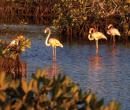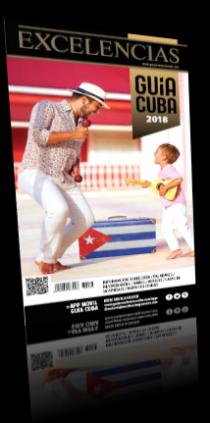- Ciego de Ávila
It has, as its capital, the namesake city founded in 1840. In the old part of the city, the colonial architecture predominates alternating with modern buildings such as the Teatro Principal and the Catedral de San Eugenio de la Palma. Tourism in this province is mainly concentrated non its southern and northern keys. Parque Nacional Jardines de la Reina is one of the most important diving areas in the Caribbean, while Jardines del Rey is one of the most important tourist destinations in the country today.
Capital: Ciego de Avila
Extension: 6 496 sq. km
Municipalities: Ciego de Avila, Morón, Chambas, Florencia, Ciro Redondo, Baraguá, Majagua, Bolivia, Primero de Enero and Venezuela
Denonym: avileño/a
Limits: it limits to the north with the Old Channel of Bahamas, to the east with the province of Camagüey, to the south with the Golfo de Ana María, and to the west with the province of Sancti Spíritus.
Access: its main land access route is the Carretera Central (Central National Road) as well as secondary roads such as the Carretera del Circuito Norte and the causeway over the sea that links Cayo Coco to mainland. It has two airports: the international Máximo Gómez, and Jardines del Rey.
Places of interest
Parque Martí (Park)
Independencia, Libertad, Marcial Gómez and Honorato del Castillo streets
It is the central square of the city that has in its center a statue of José Martí and is lit with Victorian lampposts.
Teatro Principal (Theater)
13 Joaquín Agüero between Marcial Gómez and Honorato del Castillo streets, Tel 033 22 2086
A cultural institution inaugurated on March 2, 1927, is considered as the best sample of the eclectic architecture of the province of Ciego de Avila, as well as one of the theaters with the best acoustics in the country. The marbles used in its construction came from abroad and were worked by Giovanni de Marcos. Its history includes the performance of important figures of the stage world like Jorge Negrete, Ernesto Lecuona and Libertad Lamarque, among others.
Plaza Máximo Gómez (Square)
A small square located west of Parque Marti, it has a bronze statue of Máximo Gómez.
Fortín de la Trocha (Fortress)
The only one of the 7 military towers belonging to the Trocha de Júcaro to Morón, built during the War of the Ten Years (1868-1878), which still stands. La Trocha was one of the most important military engineering works built by the Spanish in America, designed to prevent the passage of Cuban troops from east to west.
Parque Nacional Jardines de la Reina (National Park)
An archipelago consisting of about 660 deserted coral cays that stretch from east to west for about 350 km on the southern coast of Ciego de Avila and Camagüey. This ecosystem is protected by the first marine park of Cuba. Among the main species that inhabit this area is the Greater Flamingo (Phoenicopterus roseus) that has extensive populations in the Golfo de Ana María. A wide coral reef borders the southern coasts of these cays, characterized by beautiful beaches of fine white sand. This is one of the best preserved ecosystems on the planet.
Morón
It is the main access to Cayo Coco and Cayo Guillermo. Known as “La Ciudad del Gallo” (The City of the Rooster), at the request of the people, On May 2, 1982, a statue of a rooster was placed at the entrance of the village, by sculptors Rita Longa and Armando Alonso.
Laguna de la Leche (Lagoon)
Located 5 km north of Morón, it owes its name to the sediments of calcium sulfate and gypsum that cover its bottom. It is the largest natural freshwater reservoir of Cuba. Departing from its west side, from La Cueva you can book boat rides for 50 minutes. Its waters abound in flamingos and other species of waterfowl.
Sitio Arqueológico Los Buchillones (Archaeological Site)
Located in Punta Alegre, about 30 km northwest of Morón, it is the site of one of the most important archaeological discoveries in Cuba, in which National Geographic Society has collaborated. The site has the perfectly preserved remains of a Taino village and some canoes. The construction of a museum in the area is planned once the investigation has been completed.
Jardines del Rey
Comprised by about 400 cays and islets, most of them uninhabited, it is part of the Archipelago Sabana-Camagüey. Baptized in 1514 by Diego Velázquez in honor of King Fernando of Spain, they are said to have been a haven for corsairs and pirates, as well as one of the favorite places for American writer Ernest Hemingway to navigate.
Preserved virgin nature beaches, one of the most extensive marine reefs in the world with 400 km, little explored scenarios and one of the most numerous greater flamingo (Phoenicopterus roseus) colonies in the region, are some of the attractions of this site that, located on the northern coast of the province, offers the visitor Coco, Guillermo and Paredón Grande keys.
Cayo Coco
With an area of 370 square km, marked by wetlands and 22 km of white sand beaches, it is a nature reserve with almost 99% of its territory covered with vegetation, which serves as a refuge for many species of fauna, including a large colony of greater flamingos. The site La Güira, recreates a settlement of charcoal makers, similar to the many that existed in the area at the beginning of the twentieth century and the Cueva del Jabalí, are two of the places you may visit in addition to its wonderful beaches. Protected by an extensive coral reef, its coasts have abundant interior lagoons and two interesting trails, that of the dune of Loma del Puerto and Las Dolinas.
Cayo Guillermo
Immortalized by American writer Ernest Hemingway in his novel "Islands in the Gulf", it has an area of 13.2 square km and three crystalline beaches with a length of 4 km of white sands, among which is Playa Pilar, which stands out for its outstanding landscape, and for having the highest dunes of Insular Caribbean with 15 m of height.
Cayo Paredón Grande
It is another of the islets of Jardines del Rey. Its marine bottoms have high landscape values. The Faro Diego Velázquez is here, built on a rocky promontory by Chinese immigrants in 1859, and is also linked to land via the causeway that passes through Cayo Coco and Cayo Guillermo.


















